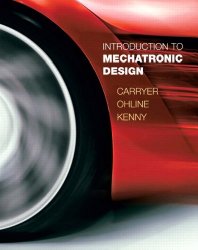Engineering Bookshelf
- Aerospace
- Biological
- Civil
- Chemical
- Environmental
- Electrical
- Materials
- Mechanical
- Petroleum
- Geoengineering
- Software

Introduction to Mechatronic Design
by J. Edward Carryer, Matthew Ohline, Thomas KennyPublisher: Prentice Hall
ISBN: 0131433563
Check price @ amazon.com , amazon.ca , amazon.co.uk
Book Description
Introduction to Mechatronic Design is ideal for upper level and graduate Mechatronics courses in Electrical, Computing, or Mechanical & Aerospace Engineering.
Unlike other texts on mechatronics that focus on derivations and calculations, Introduction to Mechatronics, 1e, takes a narrative approach, emphasizing the importance of building intuition and understanding before diving into the math. The authors believe that integration is the core of mechatronics and students must have a command of each of the domains to create the balance necessary for successful mechatronic design and devote sections of the book to each area, including mechanical, electrical, and software disciplines, as well as a section on system design and engineering. A robust package of teaching and learning resources accompanies the book.
Book Reviews
“The textbook is applied and not just a theoretical product. It reflects years of hardware experience from the authors.” - Mark Nagurka, Marquette University
“Very comprehensive…Well written with good HW problems.” - Larry Banta, West Virginia University
“What I love about this book is that it puts much of what we teach in one text allowing the students to study in more depth the details their projects require." - Daniel J. Block, University of Illinois
“The best features of the proposed text are its breadth and its detailed coverage of practical electronics.” - William R. Murray, California Polytechnic State University
“The textbook is overflowing with information. There is traditional analysis, an extensive survey of current hardware (sensors, actuators, computer hardware), practical advice (do’s & don’t’s). There is a lot to assimilate with many useful chapters that contain pedagogical examples and a wealth of practical information.” - Mark Nagurka, Marquette University
“This one volume includes many subjects that are part of the enterprise of mechatronics. The book has exceptionally strong coverage of microcontrollers.” - Mark Nagurka, Marquette University
“I expect this to become the gold standard for Mechatronics classes for years to come.” - David Fisher, Rose-Hulman
“I was very impressed with the organization of the material and the level of knowledge the authors bring to each topic. I was also impressed with the concise and clear way topics are introduced and explained.” - David Fisher, Rose-Hulman
“I think that’s great! My students get an introduction to Mechatronics then have a textbook to take with them after the course that they can continue to use and learn from.” - David Fisher, Rose-Hulman
“The authors really know their stuff and offer good guidelines, rules of thumb, and advice on dealing with real electronics, actuators, and sensors. I also really enjoyed the project discussion and trying to put into words what needs to happen in a good design process!” - David Fisher, Rose-Hulman
About the Author
Ed Carryer is the Director of the Smart Product Design Laboratory (SPDL) in the Design Division of Mechanical Engineering at Stanford University. He is¿ currently a Consulting Professor in the Design Division of Mechanical Engineering. He received his Ph.D. degree in Mechanical Engineering from Stanford University in 1992. Prior to that, he received an M.S. in Bio-Medical Engineering from the University of Wisconsin, Madison in 1978. His B.S.E. was awarded from the Illinois Institute of Technology in 1975, where he was a member (1/3) of the first graduating class of the Education and Experience in Engineering (E 3)program.
Dr. Carryer's industrial experience varies wildly, from designing water treatment facilities for coal and nuclear power plants for Sargent & Lundy to designing the electronic controller for an Arctic Heated Glove under contract to NASA. He spent eight years in the Detroit area working in and about the auto industry. During that time he worked for Ford, GM and AMC on electronic engine control systems, predominantly for turbo-charged engines. He has an active design consultancy that has tackled such varied projects as an engine controller for an outboard motor manufacturer, an automated blood gas analyzer, and a turbo-charger boost control system for a new type of turbo-charger.
Matt Ohline is an Associate Consulting Professor in the Design Division of Mechanical Engineering at Stanford University.
Thomas Kenny is a Professor in the Mechanical Engineering department at Stanford University. Dr. Kenny received his PhD in Physics from UC Berkeley.
Dr. Kenny's research group is researching fundamental issues and applications of micromechanical structures. These devices are usually fabricated from silicon wafers using integrated circuit fabrication tools. Using these techniques, the group builds sensitive accelerometers, infrared detectors, and force-sensing cantilevers. This research has many applications, including integrated packaging, inertial navigation, fundamental force measurements, experiments on bio-molecules, device cooling, bio-analytical instruments, and small robots. Because this research field is multidisciplinary in nature, work in this group is characterized by strong collaborations with other departments, as well as with local industry.
Customer Reviews
By L. Dugaiczyk
Covers myriad of engineering topics, but focuses on practical aspects, many of which are overlooked (or just lost in the details) of other EE/ME texts. Basically covers the what-you-need-to-know-to-get-it-working without much of the "boring details". Ideal for robotics projects.